What is multi-functional malware?
While traditional malware variants were designed with one specific objective in mind, the emergence of multi-functional malware, such as loader malware, means that organizations are likely to be confronted with multiple malicious tools and strains of malware at once. These threats often have non-linear attack patterns and kill chains that can quickly adapt and progress quicker than human security teams are able to react. Therefore, it is more important than ever for organizations to adopt an anomaly approach to combat increasingly versatile and fast-moving threats.
Example of Multi-functional malware
One example of a multi-functional malware recently observed by Darktrace can be seen in Gootloader, a multi-payload loader variant that has been observed in the wild since 2020. It is known to primarily target Windows-based systems across multiple industries in the US, Canada, France, Germany, and South Korea [1].
How does Gootloader malware work?
Once installed on a target network, Gootloader can download additional malicious payloads that allow threat actors to carry out a range of harmful activities, such as stealing sensitive information or encrypting files for ransom.
The Gootloader malware is known to infect networks via search engine optimization (SEO) poisoning, directing users searching for legitimate documents to compromised websites hosting a malicious payload masquerading as the desired file.
If the malware remains undetected, it paves the way for a second stage payload known as Gootkit, which functions as a banking trojan and information-stealer, or other malware tools including Cobalt Strike and Osiris [2].
Darktrace detection of Gootloader malware
In late 2023, Darktrace observed one instance of Gootloader affecting a customer in the US. Thanks to its anomaly-focused approach, Darktrace quickly identified the anomalous activity surrounding this emerging attack and brought it to the immediate attention of the customer’s security team. All the while, Darktrace's Autonomous Response was in place and able to autonomously intervene, containing the suspicious activity and ensuring the Gootloader compromise could not progress any further.
Autonomous Response was in place and able to autonomously intervene, containing the suspicious activity and ensuring the Gootloader compromise could not progress any further.
In September 2023, Darktrace identified an instance of the Gootloader malware attempting to propagate within the network of a customer in the US. Darktrace identified the first indications of the compromise when it detected a device beaconing to an unusual external location and performing network scanning. Following this, the device was observed making additional command-and-control (C2) connections, before finally downloading an executable (.exe) file which likely represented the download of a further malicious payload.
As this customer had subscribed to the Proactive Notification Service (PTN), the suspicious activity was escalated to the Darktrace Security Operations Center (SOC) for further investigation by Darktrace’s expert analysts. The SOC team were able to promptly triage the incident and advise urgent follow-up actions.
Gootloader Attack Overview

Initial Beaconing and Scanning Activity
On September 21, 2023, Darktrace observed the first indications of compromise on the network when a device began to make regular connections to an external endpoint that was considered extremely rare for the network, namely ‘analyzetest[.]ir’.
Although the endpoint did not overtly seem malicious in nature (it appeared to be related to laboratory testing), Darktrace recognized that it had never previously been seen on the customer’s network and therefore should be treated with caution. This initial beaconing activity was just the beginning of the malicious C2 communications, with several additional instances of beaconing detected to numerous suspicious endpoints, including funadhoo.gov[.]mv, tdgroup[.]ru’ and ‘army.mil[.]ng.
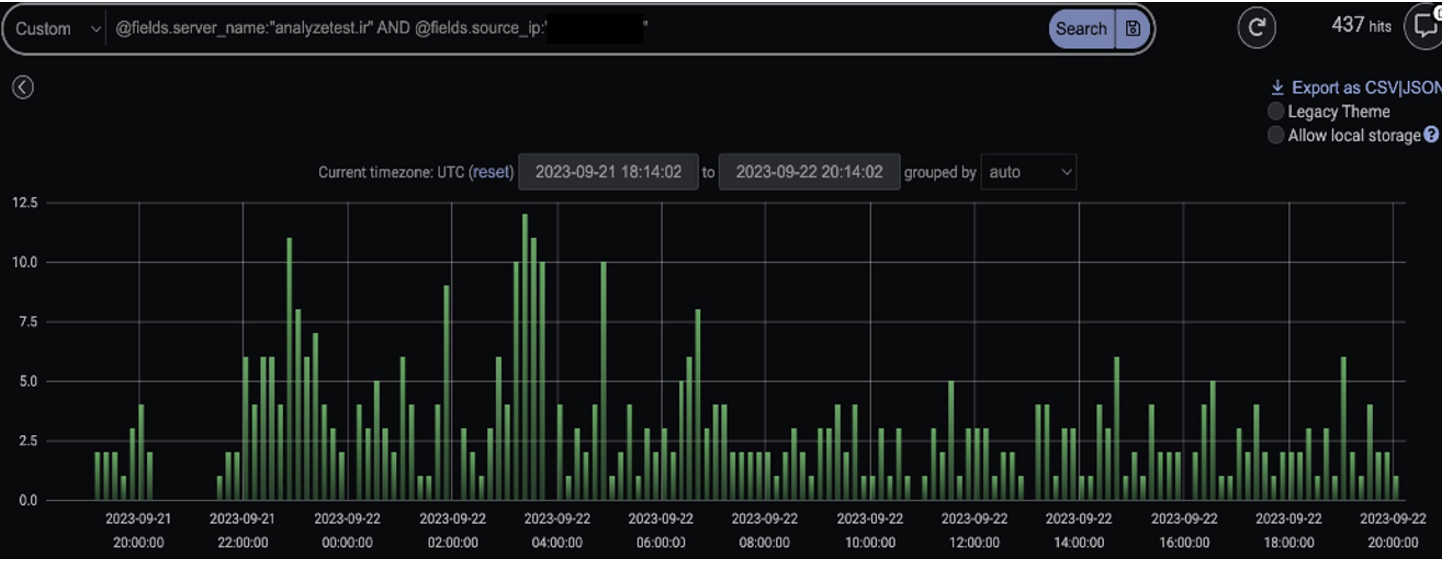
Soon thereafter, Darktrace detected the device performing internal reconnaissance, with an unusually large number of connections to other internal locations observed. This scanning activity appeared to primarily be targeting the SMB protocol by scanning port 445.
Within seconds of Darktrace's detection of this suspicious SMB scanning activity, Darktrace's Autonomous Response moved to contain the compromise by blocking the device from connecting to port 445 and enforcing its ‘pattern of life’. Darktrace’s Self-Learning AI enables it to learn a device’s normal behavior and recognize if it deviates from this; by enforcing a pattern of life on an affected device, malicious activity is inhibited but the device is allowed to continue its expected activity, minimizing disruption to business operations.
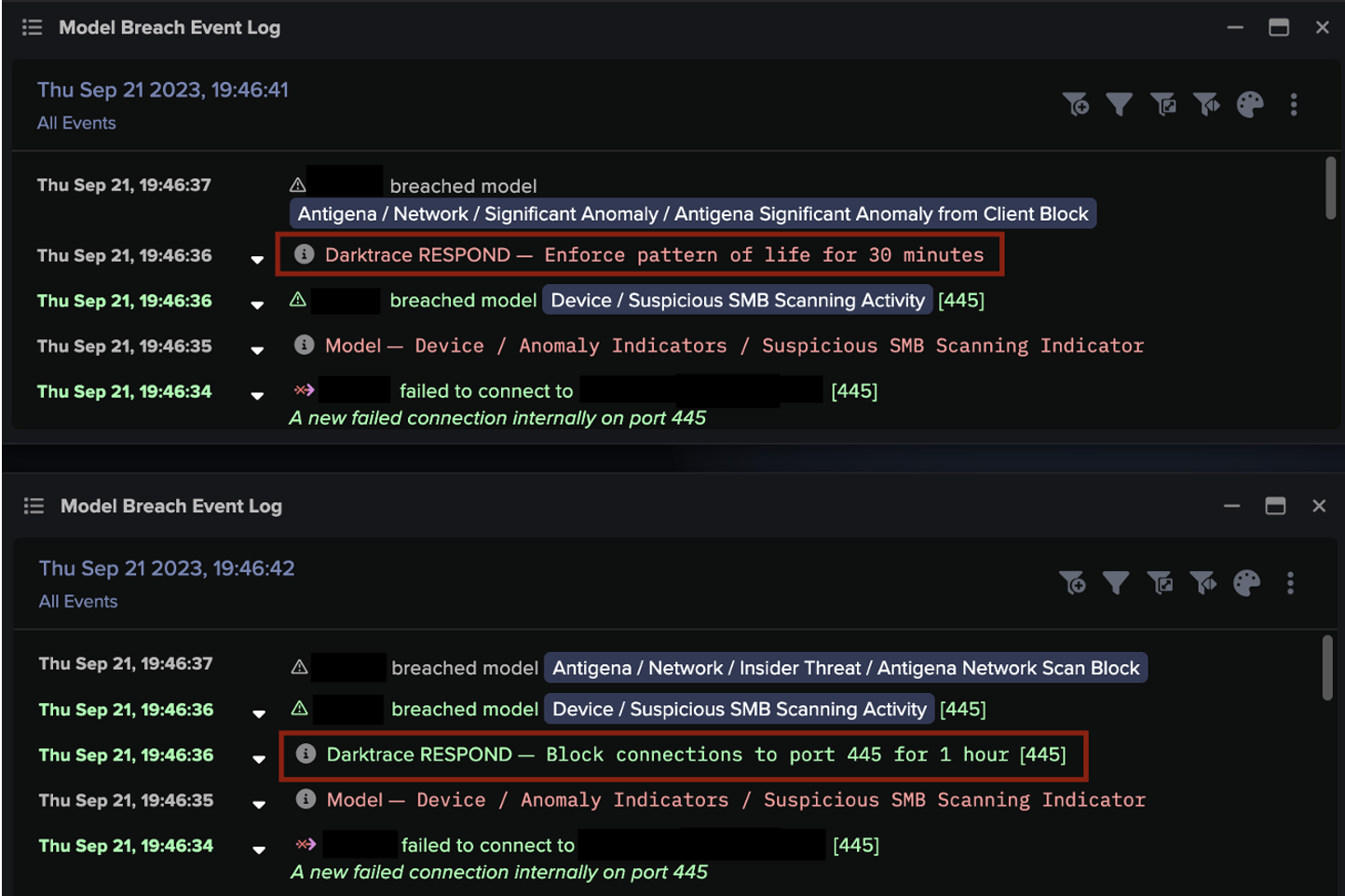
Following the initial detection of this anomalous activity, Darktrace’s Cyber AI Analyst launched an autonomous investigation into the beaconing and scanning activity and was able to connect these seemingly separate events into one incident. AI Analyst analyzes thousands of connections to hundreds of different endpoints at machine speed and then summarizes its findings in a single pane of glass, giving customers the necessary information to assess the threat and begin remediation if necessary. This significantly lessens the burden for human security teams, saving them previous time and resources, while ensuring they maintain full visibility over any suspicious activity on their network.
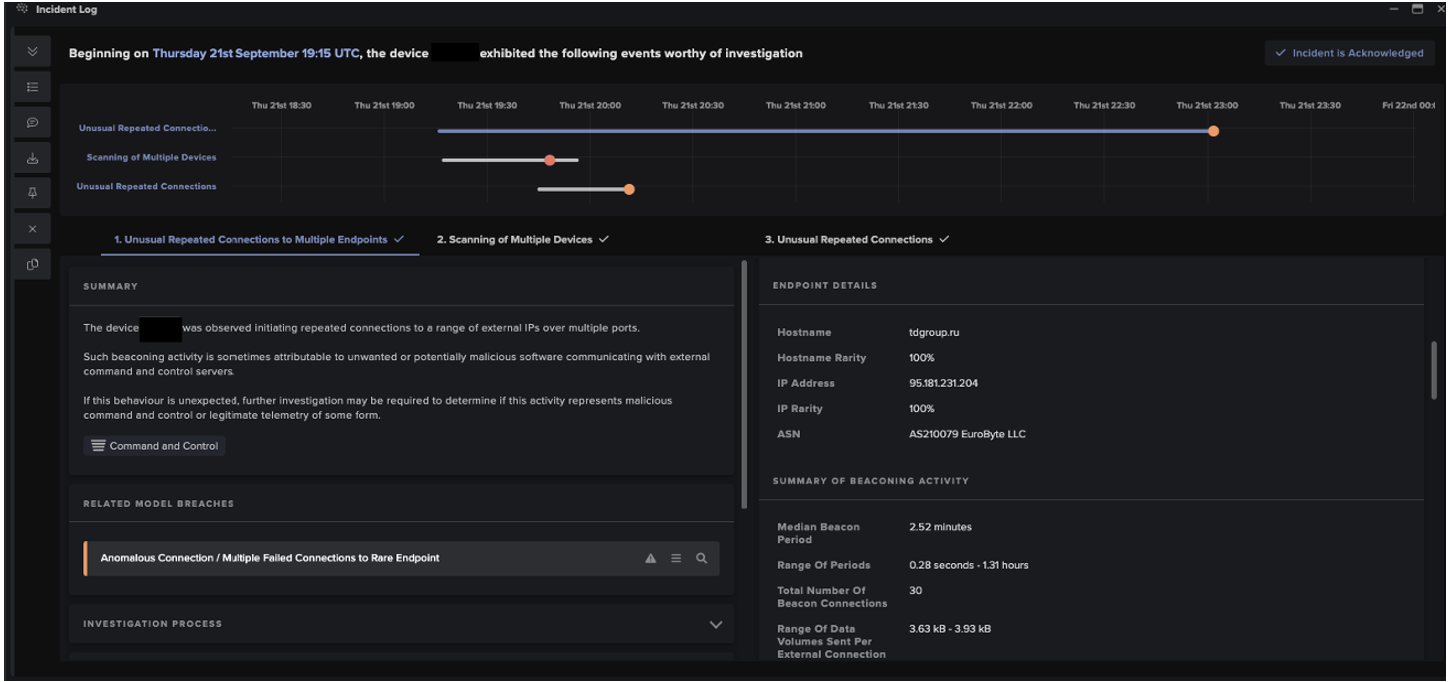
Beaconing Continues
Darktrace continued to observe the device carrying out beaconing activity over the next few days, likely representing threat actors attempting to establish communication with their malicious infrastructure and setting up a foothold within the customer’s environment. In one such example, the device was seen connecting to the suspicious endpoint ‘fysiotherapie-panken[.]nl’. Multiple open-source intelligence (OSINT) vendors reported this endpoint to be a known malware delivery host [3].
Once again, Darktrace Autonomous Response was in place to quickly intervene in response to these suspicious external connection attempts. Over the course of several days, Darktrace blocked the offending device from connecting to suspicious endpoints via port 443 and enforced its pattern of life. These autonomous actions by Darktrace effectively mitigated and contained the attack, preventing it from escalating further along the kill chain and providing the customer’s security team crucial time to take act and employ their own remediation.
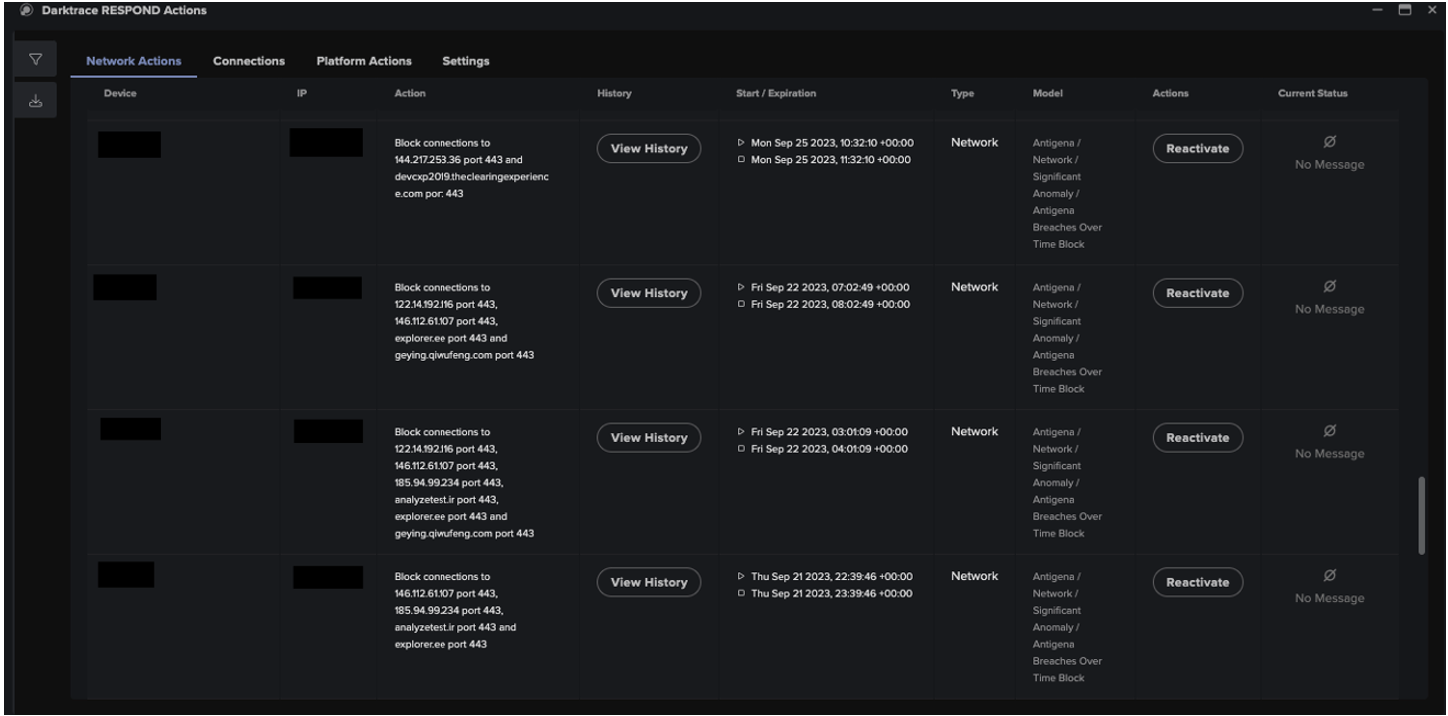
Possible Payload Retrieval
A few days later, on September 26, 2023, Darktrace observed the affected device attempting to download a Windows Portable Executable via file transfer protocol (FTP) from the external location ‘ftp2[.]sim-networks[.]com’, which had never previously been seen on the network. This download likely represented the next step in the Gootloader infection, wherein additional malicious tooling is downloaded to further cement the malicious actors’ control over the device. In response, Darktrace immediately blocked the device from making any external connections, ensuring it could not download any suspicious files that may have rapidly escalated the attackers’ efforts.
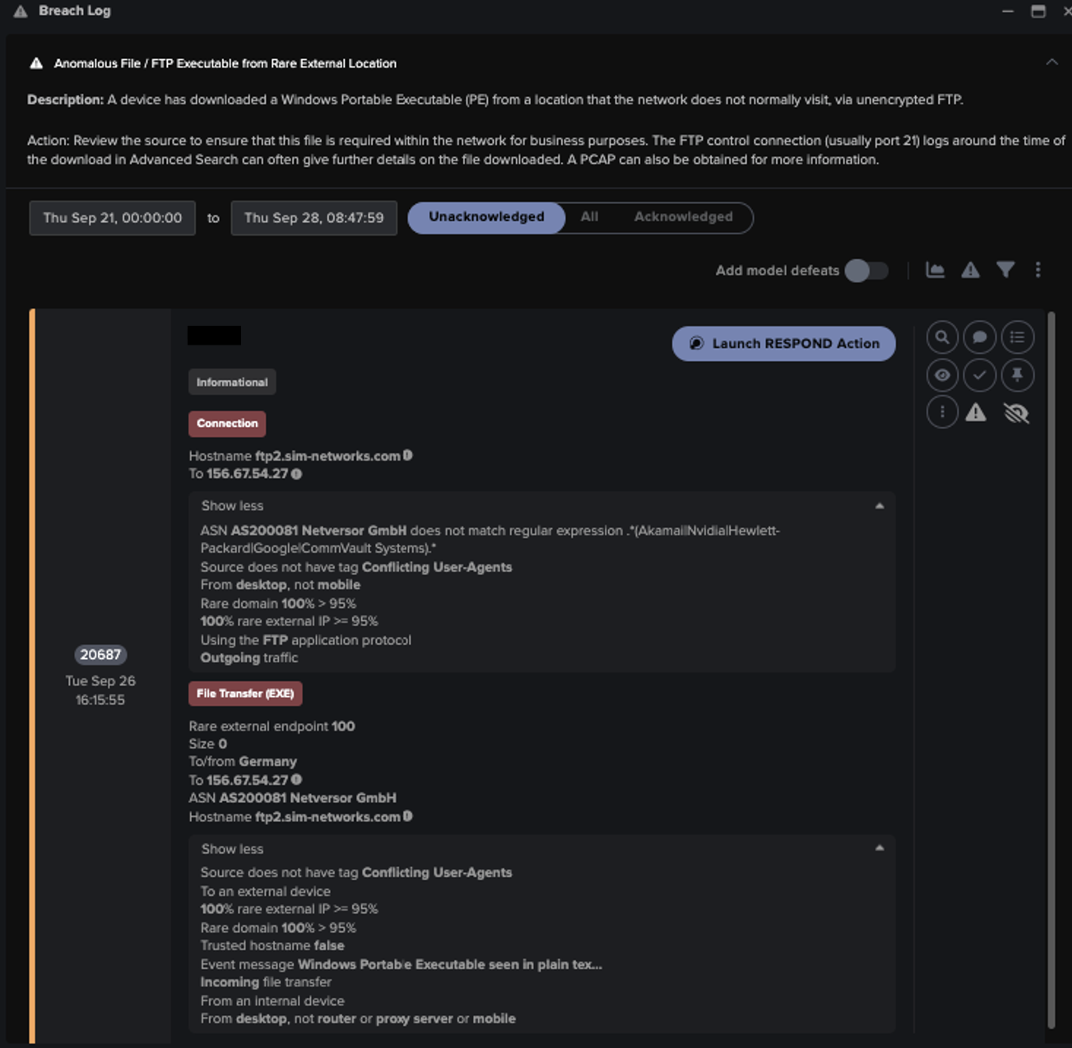
The observed combination of beaconing activity and a suspicious file download triggered an Enhanced Monitoring breach, a high-fidelity DETECT model designed to detect activities that are more likely to be indicative of compromise. These models are monitored by the Darktrace SOC round the clock and investigated by Darktrace’s expert team of analysts as soon as suspicious activity emerges.
In this case, Darktrace’s SOC triaged the emerging activity and sent an additional notice directly to the customer’s security team, informing them of the compromise and advising on next steps. As this customer had subscribed to Darktrace’s Ask the Expert (ATE) service, they also had a team of expert analysts available to them at any time to aid their investigations.

Conclusion
Loader malware variants such as Gootloader often lay the groundwork for further, potentially more severe threats to be deployed within compromised networks. As such, it is crucial for organizations and their security teams to identify these threats as soon as they emerge and ensure they are effectively contained before additional payloads, like information-stealing malware or ransomware, can be downloaded.
In this instance, Darktrace demonstrated its value when faced with a multi-payload threat by detecting Gootloader at the earliest stage and responding to it with swift targeted actions, halting any suspicious connections and preventing the download of any additional malicious tooling.
Darktrace DETECT recognized that the beaconing and scanning activity performed by the affected device represented a deviation from its expected behavior and was indicative of a potential network compromise. Meanwhile, Darktrace ensured that any suspicious activity was promptly shut down, buying crucial time for the customer’s security team to work with Darktrace’s SOC to investigate the threat and quarantine the compromised device.
Credit to: Ashiq Shafee, Cyber Security Analyst, Qing Hong Kwa, Senior Cyber Analyst and Deputy Analyst Team Lead, Singapore
Appendices
Darktrace DETECT Model Detections
Anomalous Connection / Rare External SSL Self-Signed
Device / Suspicious SMB Scanning Activity
Anomalous Connection / Young or Invalid Certificate SSL Connections to Rare
Compromise / High Volume of Connections with Beacon Score
Compromise / Beacon to Young Endpoint
Compromise / Beaconing Activity To External Rare
Compromise / Slow Beaconing Activity To External Rare
Compromise / Beacon for 4 Days
Anomalous Connection / Suspicious Expired SSL
Anomalous Connection / Multiple Failed Connections to Rare Endpoint
Compromise / Sustained SSL or HTTP Increase
Compromise / Large Number of Suspicious Successful Connections
Compromise / Large Number of Suspicious Failed Connections
Device / Large Number of Model Breaches
Anomalous File / FTP Executable from Rare External Location
Device / Initial Breach Chain Compromise
RESPOND Models
Antigena / Network / Significant Anomaly / Antigena Breaches Over Time Block
Antigena / Network / Significant Anomaly / Antigena Significant Anomaly from Client Block
Antigena / Network/Insider Threat/Antigena Network Scan Block
Antigena / Network / Significant Anomaly / Antigena Enhanced Monitoring from Client Block
Antigena / Network / External Threat / Antigena Suspicious File Block
Antigena / Network / External Threat / Antigena File then New Outbound Block
Antigena / Network / External Threat / Antigena Suspicious Activity Block
List of Indicators of Compromise (IoCs)
Type
Hostname
IoCs + Description
explorer[.]ee - C2 Endpoint
fysiotherapie-panken[.]nl- C2 Endpoint
devcxp2019.theclearingexperience[.]com- C2 Endpoint
campsite.bplaced[.]net- C2 Endpoint
coup2pompes[.]fr- C2 Endpoint
analyzetest[.]ir- Possible C2 Endpoint
tdgroup[.]ru- C2 Endpoint
ciedespuys[.]com- C2 Endpoint
fi.sexydate[.]world- C2 Endpoint
funadhoo.gov[.]mv- C2 Endpoint
geying.qiwufeng[.]com- C2 Endpoint
goodcomix[.]fun- C2 Endpoint
ftp2[.]sim-networks[.]com- Possible Payload Download Host
MITRE ATT&CK Mapping
Tactic – Technique
Reconnaissance - Scanning IP blocks (T1595.001, T1595)
Command and Control - Web Protocols , Application Layer Protocol, One-Way Communication, External Proxy, Non-Application Layer Protocol, Non-Standard Port (T1071.001/T1071, T1071, T1102.003/T1102, T1090.002/T1090, T1095, T1571)
Collection – Man in the Browser (T1185)
Resource Development - Web Services, Malware (T1583.006/T1583, T1588.001/T1588)
Persistence - Browser Extensions (T1176)
References
1. https://www.blackberry.com/us/en/solutions/endpoint-security/ransomware-protection/gootloader
2. https://redcanary.com/threat-detection-report/threats/gootloader/
3. https://www.virustotal.com/gui/domain/fysiotherapie-panken.nl































.jpeg)






